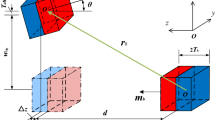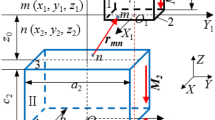Abstract
As a functional material, permanent magnets (PMs) are widely used in magnetic actuation, magnetic bearings, energy harvesters, and lithography semiconductor industries. The magnetic stiffness determines the stability and performance of the magnetic systems. Therefore, an accurate and efficient magnetic stiffness model tool is needed. This paper newly establishes an improved high precision magnetic stiffness model between two cylindrical PMs for parallel and perpendicular magnetization directions, which takes the PMs' relative permeability, residual magnetic flux density, magnetization direction, dimensions, and relative positions into account. The magnetic stiffness model is solved by a numerical algorithm. Moreover, the magnetic stiffness calculation results are indirectly validated by the finite-element method (FEM) and experimental measurement, and the accuracy and efficacy of the established model are demonstrated. Furthermore, the sensitivity of magnetic stiffness to magnets’ size and position parameters is explored, and the influence of these parameters on magnetic stiffness characteristics is studied and discussed. The results indicate that the relative positions between PMs have a significant influence on magnetic stiffness. Thus the accurate control of the relative position is important to design PM devices. In addition, the developed magnetic stiffness model has lower computational efforts than the FEM and lower costs than experimental measurement. The model includes all magnetic properties and relative positions parameters, which can calculate the principal magnetic stiffness and cross-coupling magnetic stiffness and doesn't produce any principle error. The established model makes it easy to design and optimize PM devices that depend on magnetic stiffness, such as magnetic bearings, magnetic vibration isolator, magnetic piezoelectric cantilever beam energy harvester, etc.












Similar content being viewed by others
Abbreviations
- B :
-
Magnetic flux density
- B r :
-
Residual magnetic flux density
- df :
-
Differential magnetic force
- e :
-
Relative position between the two parallel PMs’ central axes along z-axis
- F :
-
Magnetic force
- F x, F y, F z :
-
Magnetic force components along the x/y/z-direction
- h :
-
Distance between two perpendicular PMs along the x-axis
- K :
-
Magnetic stiffness
- L :
-
Length
- M :
-
Magnetization vector
- n :
-
Outward unit normal vector
- Q m :
-
Magnetic charges
- r 1 :
-
Distance vector from the center of surface 2 to point P
- r 2 :
-
Distance vector from the center of surface 3 to point Q
- R :
-
Radius
- S :
-
Surface
- V :
-
Volume
- x 0 :
-
Axial displacement between two parallel PMs along x-axis
- α :
-
Angle between the vector r1 and the z-axis
- β :
-
Angle between the vector r2 and the z-axis
- μ 0 :
-
Permeability of vacuum
- μ r :
-
Relative permeability
- \(\sigma_{m}\) :
-
Surface magnetic charge density
- \(\rho_{m}\) :
-
Volume magnetic charge density
- \(\Delta A\) :
-
Area elements
References
Zhou W, Wang B, Lim CW, Yang Z (2020) A distributed-parameter electromechanical coupling model for a segmented arc-shaped piezoelectric energy harvester. Mech Syst Signal Process 146:107005. https://doi.org/10.1016/j.ymssp.2020.107005
Seong S, Hu C, Lee S (2017) Design under uncertainty for reliable power generation of piezoelectric energy harvester. J Intell Mater Syst Struct 28:2437–2449. https://doi.org/10.1177/1045389X17689945
Yang Z, Wang YQ, Zuo L, Zu J (2017) Introducing arc-shaped piezoelectric elements into energy harvesters. Energy Convers Manage 148:260–266. https://doi.org/10.1016/j.enconman.2017.05.073
Jung J, Kim P, Lee JI, Seok J (2015) Nonlinear dynamic and energetic characteristics of piezoelectric energy harvester with two rotatable external magnets. Int J Mech Sci 92:206–222. https://doi.org/10.1016/j.ijmecsci.2014.12.015
Cao Y, Huang H, Zhu ZH, Su S (2019) Optimized energy harvesting through piezoelectric functionally graded cantilever beams. Smart Mater Struct. https://doi.org/10.1088/1361-665X/aaf761
Song HC, Kim SW, Kim HS et al (2020) Piezoelectric energy harvesting design principles for materials and structures: material figure-of-merit and self-resonance tuning. Adv Mater 32:1–34. https://doi.org/10.1002/adma.202002208
Hu G, Liang J, Lan C, Tang L (2020) A twist piezoelectric beam for multi-directional energy harvesting. Smart Mater Struct. https://doi.org/10.1088/1361-665X/abb648
Li H, Liu D, Wang J et al (2020) Broadband bimorph piezoelectric energy harvesting by exploiting bending-torsion of L-shaped structure. Energy Convers Manage 206:112503. https://doi.org/10.1016/j.enconman.2020.112503
Nie X, Tan T, Yan Z et al (2019) Broadband and high-efficient L-shaped piezoelectric energy harvester based on internal resonance. Int J Mech Sci 159:287–305. https://doi.org/10.1016/j.ijmecsci.2019.06.009
Wu Y, Qiu J, Zhou S et al (2018) A piezoelectric spring pendulum oscillator used for multi-directional and ultra-low frequency vibration energy harvesting. Appl Energy 231:600–614. https://doi.org/10.1016/j.apenergy.2018.09.082
Jeong S, Cho JY, Sung TH, Yoo HH (2017) Electromechanical modeling and power performance analysis of a piezoelectric energy harvester having an attached mass and a segmented piezoelectric layer. Smart Mater Struct. https://doi.org/10.1088/1361-665X/aa550b
Castagnetti D (2019) A simply tunable electromagnetic pendulum energy harvester. Meccanica 54:749–760. https://doi.org/10.1007/s11012-019-00976-7
Ravaud R, Lemarquand G, Lemarquand V (2009) Force and stiffness of passive magnetic bearings using permanent magnets. Part 2: radial magnetization. IEEE Trans Magn 45:3334–3342. https://doi.org/10.1109/TMAG.2009.2025315
Ravaud R, Lemarquand G, Lemarquand V (2009) Force and stiffness of passive magnetic bearings using permanent magnets. Part 1: axial magnetization. IEEE Trans Magn 45:2996–3002. https://doi.org/10.1109/TMAG.2009.2025315
Jungmayr G, Marth E, Amrhein W et al (2014) Analytical stiffness calculation for permanent magnetic bearings with soft magnetic materials. IEEE Trans Magn 50:8300108
Van Casteren DTEH, Paulides JJH, Janssen JLG, Lomonova EA (2015) Analytical force, stiffness, and resonance frequency calculations of a magnetic vibration isolator for a microbalance. IEEE Trans Ind Appl 51:204–210. https://doi.org/10.1109/TIA.2014.2328780
Santra T, Roy D, Choudhury AB, Yamada S (2019) Experimental verification of force and stiffness between two ring magnets calculated by Monte Carlo integration technique. J Instit Eng India Ser B 100:123–129. https://doi.org/10.1007/s40031-019-00373-4
Zhu P, Ren X, Qin W, Zhou Z (2017) Improving energy harvesting in a tri-stable piezomagnetoelastic beam with two attractive external magnets subjected to random excitation. Arch Appl Mech 87:45–57. https://doi.org/10.1007/s00419-016-1175-z
Stanton SC, McGehee CC, Mann BP (2010) Nonlinear dynamics for broadband energy harvesting: INVESTIGATION of a bistable piezoelectric inertial generator. Physica D 239:640–653. https://doi.org/10.1016/j.physd.2010.01.019
Zhou Z, Qin W, Zhu P (2016) Improve efficiency of harvesting random energy by snap-through in a quad-stable harvester. Sens Actuators A 243:151–158. https://doi.org/10.1016/j.sna.2016.03.024
Zhou Z, Qin W, Zhu P (2018) Harvesting performance of quad-stable piezoelectric energy harvester: modeling and experiment. Mech Syst Signal Process 110:260–272. https://doi.org/10.1016/j.ymssp.2018.03.023
Leng Y, Tan D, Liu J et al (2017) Magnetic force analysis and performance of a tri-stable piezoelectric energy harvester under random excitation. J Sound Vib 406:146–160. https://doi.org/10.1016/j.jsv.2017.06.020
Yan B, Ma H, Zhao C et al (2018) A vari-stiffness nonlinear isolator with magnetic effects: theoretical modeling and experimental verification. Int J Mech Sci 148:745–755. https://doi.org/10.1016/j.ijmecsci.2018.09.031
Zheng Y, Zhang X, Luo Y et al (2016) Design and experiment of a high-static-low-dynamic stiffness isolator using a negative stiffness magnetic spring. J Sound Vib 360:31–52. https://doi.org/10.1016/j.jsv.2015.09.019
Zhou Z, Chen S, Xia D et al (2019) The design of negative stiffness spring for precision vibration isolation using axially magnetized permanent magnet rings. JVC/J Vib Control 25:2667–2677. https://doi.org/10.1177/1077546319866035
Zhang F, Xu M, Shao S, Xie S (2020) A new high-static-low-dynamic stiffness vibration isolator based on magnetic negative stiffness mechanism employing variable reluctance stress. J Sound Vib 476:115322. https://doi.org/10.1016/j.jsv.2020.115322
Li Q, Li S, Li F et al (2020) Analysis and experiment of vibration isolation performance of a magnetic levitation vibration isolator with rectangular permanent magnets. J Vib Eng Technol 8:751–760. https://doi.org/10.1007/s42417-019-00188-z
Wang G, Liao WH, Zhao Z et al (2019) Nonlinear magnetic force and dynamic characteristics of a tri-stable piezoelectric energy harvester. Nonlinear Dyn 97:2371–2397. https://doi.org/10.1007/s11071-019-05133-z
Wang G, Wu H, Liao WH et al (2020) A modified magnetic force model and experimental validation of a tri-stable piezoelectric energy harvester. J Intell Mater Syst Struct 31:967–979. https://doi.org/10.1177/1045389X20905975
Jansen JW, Van Lierop CMM, Lomonova EA, Vandenput AJ (2007) Modeling of magnetically levitated planar actuators with moving magnets. IEEE Trans Magn 43:15–25. https://doi.org/10.1109/TMAG.2006.886051
Qu C, Pei YC, Li ZX (2021) a study on magnetic force characteristics between two cuboidal permanent magnets. J Supercond Novel Magn 34:2441–2454. https://doi.org/10.1007/s10948-021-05927-6
Furlani EP (1993) Formulas for the force and torque of axial couplings. IEEE Trans Magn 29:2295–2301
Janssen JLG, Paulides JJH, Compter JC, Lomonova EA (2010) Three-dimensional analytical calculation of the torque between permanent magnets in magnetic bearings. IEEE Trans Magn 46:1748–1751. https://doi.org/10.1109/TMAG.2010.2043224
Kremers MFJ, Paulides JJH, Ilhan E et al (2013) Relative permeability in a 3D analytical surface charge model of permanent magnets. IEEE Trans Magn 49:2299–2302. https://doi.org/10.1109/TMAG.2013.2239976
Furlani EP (1993) A formula for the levitation force between magnetic disks. IEEE Trans Magn 29:4165–4169. https://doi.org/10.1109/20.280867
Qu C, Pei YC, Xin QY et al (2021) A reciprocating permanent magnetic actuator for driving magnetic micro robots in fluids. Proc Inst Mech Eng C J Mech Eng Sci. https://doi.org/10.1177/09544062211014547
Challa VR, Prasad MG, Shi Y, Fisher FT (2008) A vibration energy harvesting device with bidirectional resonance frequency tunability. Smart Mater Struct. https://doi.org/10.1088/0964-1726/17/01/015035
Qu C, Pei YC, Xu L et al (2020) A study on electromagnetic field and force for magnetic micro-robots applications. Progr Electromag Res M 97:201–213. https://doi.org/10.2528/PIERM20073005
Acknowledgements
This work was supported by the Natural Science Foundation of Jilin Province [Grant Number 20170101060JC]; and the Graduate Innovation Fund of Jilin University.
Author information
Authors and Affiliations
Corresponding author
Ethics declarations
Conflict of interest
The authors declare that they have no conflict of interest.
Additional information
Publisher's Note
Springer Nature remains neutral with regard to jurisdictional claims in published maps and institutional affiliations.
Rights and permissions
About this article
Cite this article
Qu, C., Pei, YC., Yang, F. et al. An investigation on the improved magnetic stiffness model and characteristic analysis for two cylindrical permanent magnets. Meccanica 57, 677–696 (2022). https://doi.org/10.1007/s11012-021-01461-w
Received:
Accepted:
Published:
Issue Date:
DOI: https://doi.org/10.1007/s11012-021-01461-w




